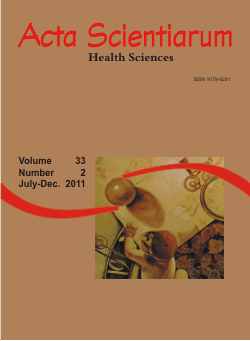Evaluation of essential oils with insecticidal activity in <em>Triatoma infestans</em> (Klug, 1834) (Hemiptera: Reduviidae)
Keywords:
Fumigation, Anacardium humile, Cymbopogon nardus, Ocimum basilicum, Eucalyptus urograndis, Triatoma infestans
Abstract
Chagas disease is a major public health problem in Latin America. This work aimed to evaluate the insecticide action of essential oils of Anacardium humile, Cymbopogon nardus, Ocimum basilicum and Eucalyptus urograndis on Triatoma infestans nymphs of third and fourth stages of development by topic action and steam pressure (fumigation). Two repetitions were performed at the topic test with five nymphs of third and fourth stages of development of T. infestans. It was applied 1µL of each concentration on the dorsal region of each nymph. Two-liter pots with sealing covers were used at the fumigation test. The essential oils of O. gratissimum and E. urograndis showed insecticidal activity against T. infestans and A. humile and C. nardus showed an average of 5 and 15% mortality, respectively. For the fumigation, only the E. urograndis oil had effect with 100% of mortality on T. infestans and for the other oils it was not observed any effect of the steam pressure. This paper describes for the first time the insecticidal action of E. urograndis in smoke canister to control bugs. The results are important to the search for new molecular models with insecticidal action in bugs which are resistant to synthetic insecticides.Downloads
Download data is not yet available.
Published
2011-03-29
How to Cite
Gomes, S. P., & Favero, S. (2011). Evaluation of essential oils with insecticidal activity in <em>Triatoma infestans</em> (Klug, 1834) (Hemiptera: Reduviidae). Acta Scientiarum. Health Sciences, 33(2), 147-151. https://doi.org/10.4025/actascihealthsci.v33i2.9531
Issue
Section
Pharmacy
DECLARATION OF ORIGINALITY AND COPYRIGHTS
I Declare that current article is original and has not been submitted for publication, in part or in whole, to any other national or international journal.
The copyrights belong exclusively to the authors. Published content is licensed under Creative Commons Attribution 4.0 (CC BY 4.0) guidelines, which allows sharing (copy and distribution of the material in any medium or format) and adaptation (remix, transform, and build upon the material) for any purpose, even commercially, under the terms of attribution.
Read this link for further information on how to use CC BY 4.0 properly.























5.png)







